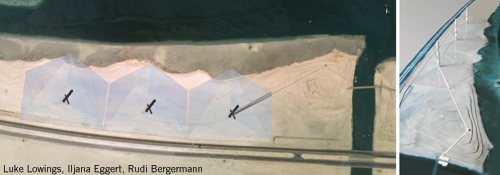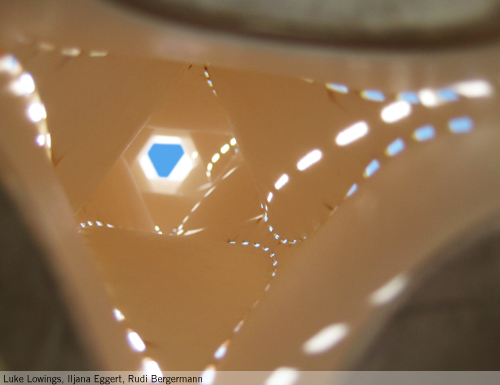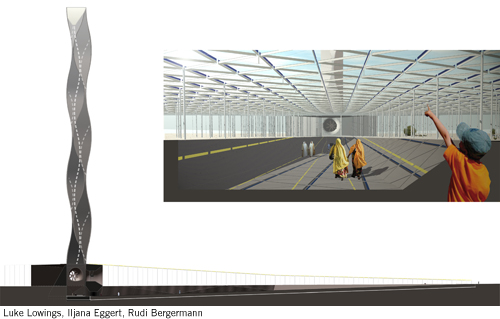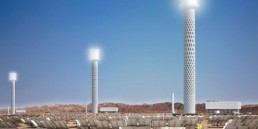Carpenter / Lowings Architecture and Design
Luke Lowings, Iljana Eggert, Rudi Bergermann
Designed for Site #2 in Abu Dhabi, between Saadiyat Island and Yas Island.

Design Submission for the 2010 Land Art Generator Initiative Design Competition
Artist’s descriptive text:
Spaces are crafted from a clean and elegant technology, and combined into a potent experience of light, shadow, colour and sound. The intention is to connect the individual to the immense scale of the landscape and the process of energy production; to start to reconcile technology, ecology and culture.
The artwork is a complex sequence of linked events, that can be appreciated individually or in concert:
Firstly, the towers are seen from a great distance as three poised, fluid forms in light, reminiscent of columns of flowing water;
Secondly, the collector surfaces are seen as tilted prismatic planes of glass from the road during the day, or etched with delicate lines of retro-reflected light from cars against the night’s darkness;
Thirdly, for the engaged visitor slowly pacing out the immense dimensions of the land under the diaphanous membrane of glass, the work is manifested as projected and reflected lines of coloured light and patterns of shadow;
Fourthly, directly under the tower, the intense sound of rushing air, with the flickering, twisting light, creates a climactic experience that intensifies the changes that occur in the natural light over the course of the day and through the year.
The technology we propose to use is simple, requiring little maintenance and no energy in use, to leave the site as untouched as possible. The totality is site-specific: the process and artwork are sensitive to the land, climate and culture in which they are built.
Energy from the sun is clean and safe: we can occupy and learn from the spaces that create it.

The Artwork/Generator:
The collectors are arrayed toward the western part of the site, aligned with the slight curve of the road, to leave the eastern end empty. The latter is the highest part of the site. Visitors will arrive by boat or by car, approaching from the east where a floating jetty is placed at the end of the bridge. A simple informal path leads up to a small triangular shade structure at the top of the rise, commanding views of the sea and capturing breezes. This structure serves as an orientation point and viewing platform with toilet facilities and seating. From there a straight path leads toward the first tower, under the edge of the solar collector and onto a long shallow ramp into the earth.
The portion of the glass collector over the ramp is covered with a semi-opaque pattern to form a shaded canopy. The air under the collector gets gradually hotter toward the tower so, as the ramp descends, a second layer of glass at ground level separates the lower half of the ramp from the heated air in the collector above, and carries a second pattern that, with the first, forms soft hexagonal shadow patterns which blur and coalesce, dappling the light. Cooled air is drawn from shaded tubes underground through the pedestrian space. Strips of coated glass on the collector split the sunlight into its component colours, transmitting and reflecting blue and gold bars of light onto the landscape, leading the eye toward the tower.
Almost under the tower the shadows deepen again, as the passage constricts before the visitor enters a simple hexagonal room containing a raised triangular reflecting pool. Above a clear glass ceiling, the interior of the tower rises vertiginously to the sky: bars of bright light loop and float across undulating petal-like surfaces, toward the intense blue sky at the centre. The sound of the turbines spinning, the rushing of the air, the sense of heat above, and the space rising one hundred and fifty metres through streaks of light like sparks in a fire, combine into an intense sensory experience.

Technology:
The concept uses simple technologies that are well understood and tested: the greenhouse, the chimney, turbines. Energy as light passes through the glass surface of the collector, warming the ground, and the air above it. The warm air tries to rise and the gentle slope of the collector guides it toward the chimney. At the same time the high temperature at the base of the chimney and the cool temperature at the top create a pressure difference which draws the air up through the turbines, creating electricity. The advantages of this method are its simplicity, longevity, low-maintenance and minimal impact on the landscape. The elegance of the conversion of light to energy is striking.
The temperature difference between the air at the perimeter of the collector and the heated air at the tower base is approximately fifteen degrees centigrade; the speed of the air is roughly twenty-four metres per second at the turbine. This means that maintenance can be carried out without stopping production of electricity, and if mitigated cleverly the conditions would be quite tolerable for visitors. We have proposed progressively increasing the shading and a simple passive cooling system as part of the experience of the access ramp and visitor space.
The solar chimney technology has been developed and refined for many years, and a full-scale prototype roughly the same size as the towers we are proposing here, was built and tested in Manzanares in Spain for the EU between 1982 and 1989. This is a fully-considered proposal at every level.
The energy production is highest during the day, corresponding to maximum air-conditioning use, but still continues at a lower level at night due to the heat storage effect of the ground itself. Experience has shown that wind-borne dust does not have a significant effect on the energy production, as it blown off periodically. Water for washing is not required.
The heat is mitigated for visitors using a process known since ancient times in the Middle East, whereby cool air is drawn by the action of the solar tower through long, shaded tubes under the access ramp and into the observation space at the base of the tower. The cooling effect is most active when most necessary, and uses no external energy.
The rooms required for electrical equipment are located at the base of each tower at ground level in the space between the turbines.

Environmental Impact:
The physical impact on the landscape is minimised because the bases of the towers occupy a very small area on the site (0.005% of the total), and the collectors are supported from slender posts with drilled foundations which require no excavation.
The foundations of the publicly accessible tower are approximately 10m below ground level. Those of the other two are no more than 3m below. The single pedestrian access ramp is long but narrow, so the excavations would also be minimal.
Maintenance is very low on this kind of structure because the only moving parts are in the three turbines, easily accessible at the base of each tower – continuous access across the landscape would not be necessary. Vehicles would be restricted to the zone parallel and immediately adjacent to the road.
The towers are steel structures; structurally efficient to avoid waste; prefabricated in segments offsite, and fully recyclable. The collector is generally unlaminated glass (except over the visitor access ramp) and could also be recycled. Both elements could be produced locally.
It is anticipated that there would be no significant impact on the water table due to the construction, and there is no water consumption in use. There is no production of pollutants or CO2 emissions in use. The fabrication of the tower and collector would of course produce CO2 but the long lifetime of the project, low-maintenance, and zero emissions in use would mitigate this.
The temperatures under the collector would clearly be elevated and particularly around the tower base, which would have an unavoidable effect on the existing flora and fauna in the long-term. However, the extreme temperature fluctuation common in dry, hot landscapes would be reduced and the environment under the collector would develop its own particular characteristics over time. The proximity of the sea would make it possible to collect condensation at times, which could aid the growth of specific plant types.
We are taking the approach that the natural environment should be left untouched to the greatest extent possible and allowed to develop naturally without promoting any particular planting vision – the infrastructure should become an integral part of the landscape.



[…] planting vision – the infrastructure should become an integral part of the landscape. Source: Land Art Generator Initiative Reageer […]